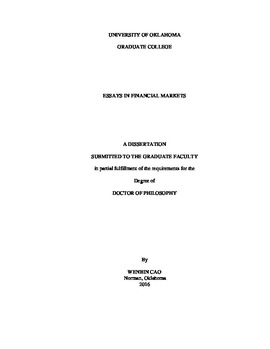| dc.description.abstract | This dissertation is a collection of three essays that analyze the impact of economic uncertainty on financial market activities and evaluate alternative quantitative models for economic uncertainty based on financial asset prices. Chapter 1 is motivated by the fact that major economic and political shocks, such as the Cuban missile crisis, the 9/11 terrorist attacks, and the 2008 financial crisis, trigger spikes in market-wide uncertainty. It develops a dynamic trading model to analyze the impacts of these uncertainty shocks on the behaviors of market liquidity and shows how such impacts differ from those caused by shocks to economic conditions. According to my model, an uncertainty shock triggers a temporary decline in market liquidity, because an uncertainty shock introduces ambiguity and learning can resolve this ambiguity. Meanwhile, incorporating the notion of time-varying uncertainty aversion, my model implies that a shock to economic condition generates a persistent decline in market liquidity, since learning does not affect uncertainty aversion. My VAR estimations using monthly US data for 1962--2013 lend support to my model implications. An uncertainty shock generates a rapid drop and rebound in overall stock market liquidity for around five months on average, while a shock to economic condition leads to a persistent decline in market liquidity for up to a year.
Chapter 2 examines the ability of five basis alternative option pricing models to price the early exercise premium (EEP) in American put prices: Black-Scholes model, Heston (1993) stochastic volatility model, and three jump pricing models – Merton (1976), Madan et al. (1998), and Carr and Wu (2003). After duly accounting for the market implied value of the Fleming and Whaley (1993) wild card option, we find that jump models perform best in pricing observed EEP. Importantly, all models consistently and significantly underprice observed EEP, where this underpricing is more pronounced for short term in-the-money EEP. We argue and empirically demonstrate that trading costs in the option market generate a significant EEP by incentivizing and rewarding early exercise of American options that would alternatively have been “sold” in the market.
Chapter 3 examines the frequency and character of price jumps in front month oil and natural gas futures prices, where prices are sampled every five seconds over the period 2006-2014. We find that an infinite activity jump diffusion process describes crude oil and natural gas futures returns combined with a process involving much larger but less frequent jumps. We further find that jumps account for respectively 36 and 41 percent of the realized variances of the crude oil and the natural gas returns. | en_US |
